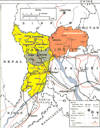 |
 |
Photo Collection
Places
India
Darjeeling
In 1877 Sri Aurobindo (5 ears old) with his brothers was send to Darjeeling by their father who determined that his children should receive an entirely European upbringing. Aurobindo and his brothers were sent to an Irish nuns’ school in Darjeeling (Loretto). Aurobindo remembered plays and walks at forest hillsides. He lived here about two years.
Maps
Loretto
an Irish nuns’ school
Views
Darjeeling also spelled Darjiling, Tibetan Dorje-Ling, town, extreme northern West Bengal state, northeastern India. Darjeeling lies 491 km north of Calcutta. The town is situated on a long, narrow mountain ridge of the Sikkim Himalayas that descends abruptly to the bed of the Great Rangit River. Altitude is 2134 metres. Outside of the monsoon season (June to September) on a clear day Darjeeling affords a magnificent view of Kanchenjunga 8,586 m, and Mount Everest can just be seen. The name of the town means “place of the thunderbolt.” Main Languages Gorkhali, Hindi, Nepali, Bhutani, Bengali, Assamese and English. Population (1981) town, 57,603.
Darjeeling is a noted hill resort that has major road, rail, and air connections with Calcutta. Bagdogra Airport (96 kms from Darjeeling) has direct air connections to Calcutta, Delhi, Patna, Guwahati and other places of North-East India. New Jalpaiguri (NJP) station at the base of Darjeeling Hill area has the direct railway connections to Calcutta, Delhi, Guwahati, Madras, Bombay, Bangalore, Bhubaneshwar, Tirupati, Trivandrum, Cochin etc. And from New Jalpaiguri to Darjeeling by toy train it takes 7 hours on a narrow gauge line. Darjeeling is connected by road with Calcutta 651 kms, Gangtok 100 kms, Kalimpong 51 kms. Calcutta-Shiliguri have direct NSBTC Buses, daily.
The area in which Darjeeling is situated receives plentiful rainfall. Often heavy down pours wash away the roads and the place is totally cut off from rest of the country. Local coniferous and oak forests yield valuable timber. Summer 14.9° (max.), 8.6° (min.); winter 6.11° (max.), 1.50° (min.). Best Season: April to middle June and September to November. The best season to visit Darjeeling is between April and June. The weather during this period is generally clear and the chilling biting cold gets subsided. Between September and November the mountains are clearly visible and one can enjoy the golden sunrise over the Himalayan peaks.
The local economy is based primarily on tea, which is plantation-grown from the Tarai up to elevations of 1,800 m. Other crops are rice, corn (maize), cardamom, and wheat.
The town was purchased in 1835 from the raja of Sikkim and was developed as a sanatorium for British troops. It was constituted a municipality in 1850.
Chaurastha, with the Mall, is the town’s main shopping centre and the most attractive promenade. Observatory Hill, the town’s highest point 2,100 m, is crowned by Mahakal Temple, which is sacred to both Hindus and Buddhists. Birch Hill contains a natural park and the Institute of Mountaineering. The Lloyd Botanic Gardens were laid out in 1865. Besides these attractions, Darjeeling has a zoo, a natural history museum (established in 1903, fauna found , 4300 specimen), a racecourse, and several hospitals. It is also the seat of the University of North Bengal, founded in 1962, with a number of affiliated colleges, including a medical schoo l, in the town.